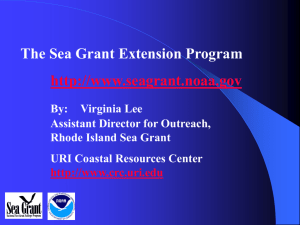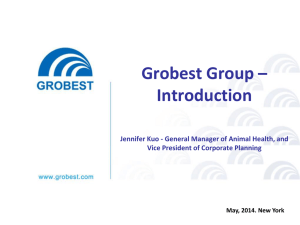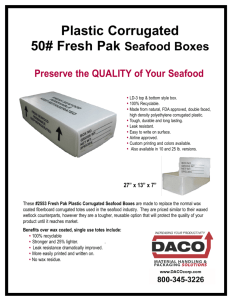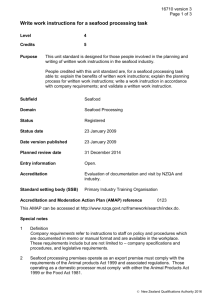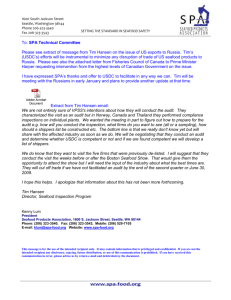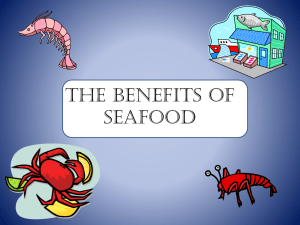Seafood Market - Watson Goepel LLP
advertisement
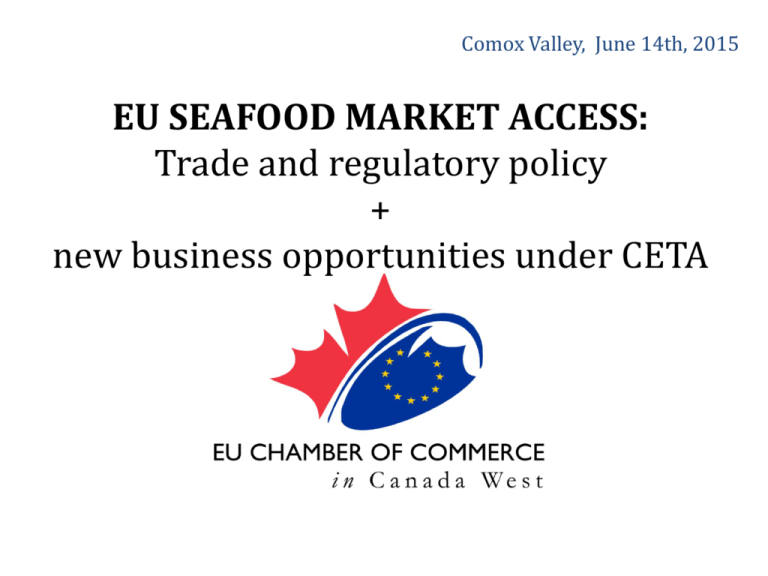
Comox Valley, June 14th, 2015 EU SEAFOOD MARKET ACCESS: Trade and regulatory policy + new business opportunities under CETA EU Seafood market: key figures Total consumption: 12.3 million tonnes: 23.81 kg per capita; CAD $72.7 billion value. Total production: 6.2 million tonnes; Net importer of seafood products: 3.59 million tonnes negative trade balance; CAD $19.2 billion value. EU’s level of seafood production constantly falling since late 1990s By far the largest single market for imported fisheries and aquaculture products: 40% of total world imports in 2010; If intra-EU trade is excluded, EU imports represented 26% of the global total. Sources: European Commission, International Trade and the EU Market for fisheries and aquaculture products, 2015 (data from 2012); EU seafood market: key products Main commercial species imported: 20% salmon 18% shrimps 20% tuna and tuna-like 9% cod 43% other products Sources: European Commission, Facts and figures on common fishery policy, 2014 (data from 2012). EU Seafood Market: a growing demand FAO projections: increase in the demand for seafood products to 2030. Average per capita consumption up to 25 kg/year in 2030. The net supply to increase by 1.6 million tonnes (Mt) Imports to rise to 11 Mt (+15% by 2030 from 1998) PROMISING EXPORT OPPORTUNITIES FOR BC SEAFOOD INDUSTRY Sources: European Parliament, European Fishery in figures; 3/2015; FAO FUTURE PROSPECTS FOR FISH AND FISHERY PRODUCTS, 2007 Exporting seafood into the EU: procedures and legislation Common Fishery Policy (CFP), common EU policy on seafood production and trade: set of rules for managing European fishing fleets and for conserving fish stocks. 4 main policy areas: 1. Fishery Management; 2. International Policy; 3.Trade and Market policies; 4. Funding policies. Trade and market policies, as import rules are harmonized, homogeneous in all 28 EU countries. Tariff barriers for seafood imports from non EU countries: 11% to 25%. Non-tariff barriers (NTB’s): quotas and guidelines for use of veterinary medicinal products, additives and metal content restrictions (detailed info on CFIA website). Autonomous tariff quotas (ATRQ’s) established every 3 years: certain quantity of selected products is allowed to be imported into the EU at a reduced tariff rate – typically, 0%, 4% or 6%. Sources: Government of Canada, Canadian Trade Commissioner Service, CFIA Exporting seafood into the EU step 1: export certificate and CFIA The Canadian Food Inspection Agency (CFIA) is responsible for regulating the export of fish and seafood products. Eligibility for export: fish and seafood destined for human consumption must originate from a registered fish processing establishment and meet defined standards. To receive a seafood export certificate: contact local CFIA office and provide following information: 1. 2. 3. 4. 5. 6. 7. 8. 9. 10. certificate type(s) lot location date available for inspection date certificate required lot size product description (size, grade, type) consignee consignor identification marks (production code) mode of transportation (if known). Sources: Canadian Trade Commissioner Service, CFIA Exporting seafood into the EU step 2: the export certificate for EU Canadian fish processors must appear on the EU list of establishments approved for export. Lists are maintained and managed by the EU Health and Consumer Protection Directory General (SANCO) (link available on the CFIA website). To request inclusion on any of the EU Approval Lists, a company must submit the following information to local CFIA office: 1. Registration or fish export licence number; 2. Full legal name as it appears on the certificate of registration; 3. Physical site address as it appears on the certificate of registration; 4. Species to be exported to the EU, indicating whether any aqua-cultured raw material is to be used. The approval process takes approximately 3 months. Sources: Canadian Trade Commissioner Service, CFIA Exporting seafood into the EU: New labelling requirements New regulations on labelling (all 28 EU countries) since December 2014. Uniform labelling characteristics for fishery products sold in the EU in order to ensure transparent internal market that supplies high-quality products. 2 categories: 1. Unprocessed and certain processed prepacked fresh products; 2. Processed products; Example: list of major mandatory information for unprocessed and some processed products (e.g. salted, smoked products, cooked shrimps in their shells). These products can be 'prepacked’ and 'non-prepacked': MANDATORY FOR ALL: Commercial designation and scientific name; Production method; Catch Area/ country and body of water; Fishing gear; Defrosted or not; Best before; Allergens; ADDITIONAL MANDATORY FOR PACKED ONES: List and quantity of ingredients; Net quantity; Condition for storage and use; Name of the business; Date of first freezing; Added water; (…..) Sources: European Commission, 2015 Exporting seafood into the EU: Labelling for unprocessed fresh products Sources: European Commission, 2015 Exporting seafood into the EU: Labelling for processed products More info at the Website of European Commission, fisheries section: http://ec.europa.eu/fisheries/cfp/market/index_en.htm Exporting seafood into the EU: a snapshot of Canada`s exports Canada has one of the world’s most valuable commercial fishing industries, $2.2 billion contribution to Canada’s GDP in 2013; 38,300 jobs to Canadians. World’s 7th largest exporter of fish and seafood products, exporting an estimated 70%, by value, of its fish and seafood production. Canada’s exports to the EU: worth an average of $390 million per year between 2011 and 2013; average EU tariffs of 11%, with peaks of 25%; slightly decreasing (from $396 million in 2011 to $345 million in 2012). The 5 most valuable exports to EU (accounting >50% of total): Coldwater shrimps and prawns ($138 million), frozen lobster ($41.4 million), live lobster ($39.6 million), frozen, dried or salted scallops ($34 million), salmon in airtight containers ($18.7 million). Sources: Government of Canada, Canadian Trade Commissioner Service, CFIA Exporting seafood into the EU: Selected current tariff rates Crab or Snow Crab: Frozen, in shell: 7.5%; Frozen, shelled 2kg or greater pack: 8.0%. Mussels: Live, fresh or chilled: 10%; Processed: 20%. Lobsters: Frozen: from 6% to 16%; Live: 8%. Scallops: Frozen: 8% Coldwater shrimps and prawns: There is an Autonomous Tariff Quota at the EU level which allows for 20,000 tons of cooked and peeled shrimp (Pandalus borealis) only for processing to be brought into the EU at 0% tariff. For volumes beyond that, the applied tariff is 20%. Shell-on shrimp (Pandalus borealis) is subject to an applied MFN tariff of 12%, although shell-on shrimp (Pandalus borealis), when it is imported for further processing, currently benefits from a duty suspension. Sources: Government of Canada, Canadian Trade Commissioner Service, CFIA CETA: complete tariff elimination list Immediate tariff elimination for the following products: live lobster – current duties at 8% frozen lobster – current duties from 6% and 16% frozen scallops – current duties at 8% frozen shrimp – current duties at 12% cooked and peeled shrimp in retail packages – current duties from a rate of 20% fresh or chilled hake – current duties at 15% dried and salted cod – current duties at 13% frozen herring – current duties at 15% frozen mackerel – current duties at 20% fresh or chilled halibut – current duties at 15% salmon – from rates of up to 15% processed salmon – current duties at 5.5% snow crab – from rates up to 8% fresh, chilled and frozen mussels – from rates up to 20% dogfish – from a rate of 6% Sources: Canadian Trade Commissioner Service, CFIA Duty Free provisions and derogations Duty-free transitional tariff-rate quotas (TRQs) with no end-use requirements : • processed shrimp (two tariff lines) – up to 23,000 tonnes – current duties at 20% • frozen fillets of cod (one tariff line) – up to 1,000 tonnes – current duties at 7.5% Derogations for key products processed in Canada that use imported inputs: • prepared or preserved salmon: up to 3,000 tonnes • cooked and frozen lobster: up to 2,000 tonnes • prepared and preserved sardines: up to 200 tonnes • processed shrimp: up to 5,000 tonnes CETA: opening the EU market for Canada’s seafood industry When CETA comes into force (expected in 2016) almost 96% of EU tariffs lines for fish and seafood products imported from Canada will be eliminated. In 7 years, 100% of Canadian seafood products will access the EU market duty-free, becoming more competitive and creating favourable conditions for increased sales. Get ready NOW! THANK YOU FOR YOUR ATTENTION Celso Boscariol – President T: 604 559 1008 / 604 375 9003 E: cboscariol@watsongoepel.com Alex Martyniak – Executive Director T: 604 559 1008 / 604 338 3533 E: alex.martyniak@eu-canada.com

